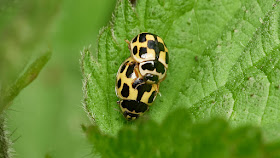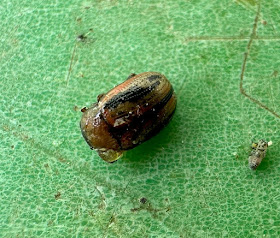Wednesday 22nd May 2024. Melverley, Common piece and other fields
The group was due to visit three areas of privately owned land near Melverley that are now being managed with minimal intervention for the benefit of wildlife.
Regrettably the weather had other plans.
The forecast of rain to fall all day led to this outing being postponed.
Thanks to the Shropshire Spider Group it has been rescheduled for Sunday 21st July. Fingers crossed that the weather will be kinder.
In the absence of a report of the outing I share with you below the many photographs that have come my way over the past week or so.
Friday 17th May 2024, Eardington Quarry
An evening of moth trapping was held at the quarry. Here are a few of the species that were observed:
A larva of a Blair’s shoulder-knot;
 |
| Photograph: David Williams |
Great crested newts;
.jpg) |
| Photograph: David Williams |
.jpg) |
| Photograph: David Williams |
A woodlouse, Platyarthrus hoffmannseggii; this small woodlouse is found in association with ants and is known as the Ant Woodlouse;
 |
| Photograph: David Williams |
A Palmate newt;
 |
| Photograph: David Williams |
A Glow-worm larva;
 |
| Photograph: David Williams |
A Puss moth;
 |
| Photograph: David Williams |
An Eyed hawk-moth;
.jpg) |
| Photograph: David Williams |
Another hawk-moth, this time a Poplar hawk-moth;
 |
| Photograph: David Williams |
A Buff-tip;
 |
| Photograph: David Williams |
And a Lobster moth.
 |
| Photograph: David Williams |
Sunday 19th May 2024, King’s Dyke Nature Reserve
King’s Dyke Nature Reserve is a private nature reserve just east of Peterborough. The photographer went there to find a ground-hopper that is not found, yet, in Shropshire. Whilst searching for this elusive insect he observed few other creatures of interest.
A hairy dragonfly.
 |
| Photograph: David Williams |
A Scarce chaser.
A Slender-horned leatherbug.
 |
| Photograph: David Williams |
A Marsh harrier.
 |
| Photograph: David Williams |
Our photographer was looking for Cepero’s ground-hopper, a species that I had never heard of until he showed me one in Manchester Museum a few weeks ago.
Unfortunately, it looks very similar to a much more commonly found ground-hopper, Slender ground-hopper.
And the Slender ground-hopper was very common on this site and he had to check over a hundred for minor features that distinguish the two.
Out of all the ground-hoppers he checked he found ONE Cepero’s!
Here it is.
 |
| Photograph: David Williams |
Wednesday 22nd May 2024, Crossways
The photographer found this rarely reported hoverfly inside his house, Brachypalpus laphriformis.
.JPG) |
| Photograph: John Lyden |
Friday 24th May 2024, Crossways
As a reward for doing the household chores the photographer noticed this sawfly, Hoplocampa alpina.
 |
| Photograph: John Lyden |
This is the first time that this sawfly has been recorded in the county.
Friday 24th May 2024, Madeley
A slow-worm was discovered when opening a bag of home produced compost.
 |
| Photograph: Nigel Cane-Honeysett |
Saturday 25th May 2024, Little Hill
A walk to the summit of Little Hill was not rewarded with the sight of Callicera rufa. The tree trunk on which at least one male has been found at this time of year was, disappointingly, devoid of hoverflies. I had to be content with this Rhagium bifasciata that took a fancy to my waterproof.
Saturday 25th May 2024, Madeley
Several similar flies were seen in the garden with a long proboscis and feathery legs. Unfortunately, it has not been possible to decide which species the flies were other than a member of the Empis genus.
 |
| Photograph: Nigel Cane-Honeysett |
Monday 27th May 2024, Swellshill
On a generally damp and disappointing Bank Holiday Monday a couple of us were able to find a good deal of sunshine near to Stroud. The only down-side was the rather stiff breeze that was difficult to find shelter from.
Swellshill is an area of grassland on a steep south-ish facing slope, close to Rodborough Common. It is generally a good site for butterflies.
However, our early successes were a couple of shieldbugs.
Bishop’s Mitre.
And from one of the Juniper bushes a Juniper shieldbug.
And then we started to find butterflies and moths.
A Common blue.
A Forester moth (or it may be a Cistus forester, they are difficult to separate).
A Dingy skipper. This was by far the most common species we saw.
A Brown argus
My thanks the photographers for providing their images for this report.





.JPG)




















.jpg)
.jpg)

.jpg)



.jpg)


.jpg)






.JPG)
.jpeg)
.jpg)